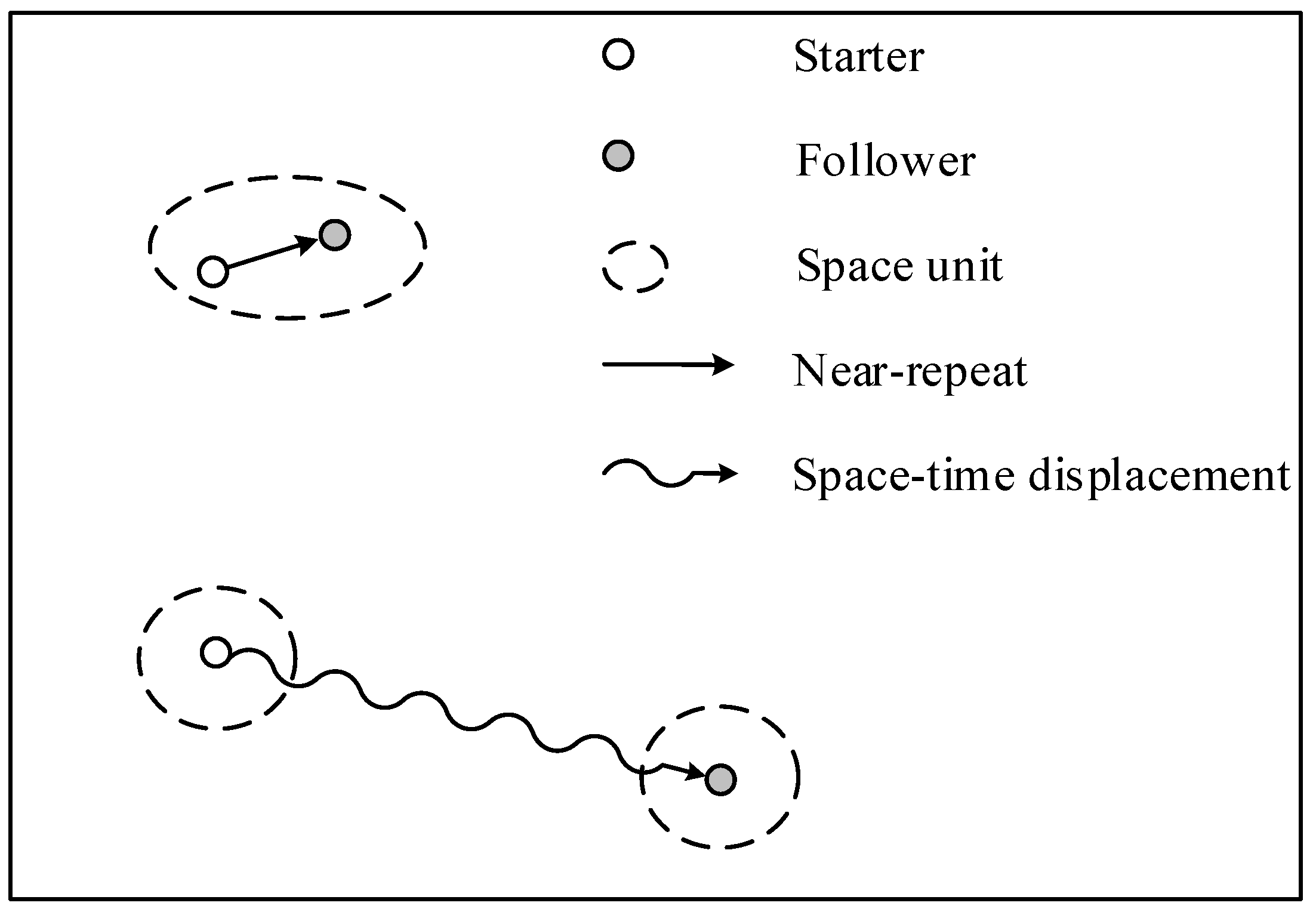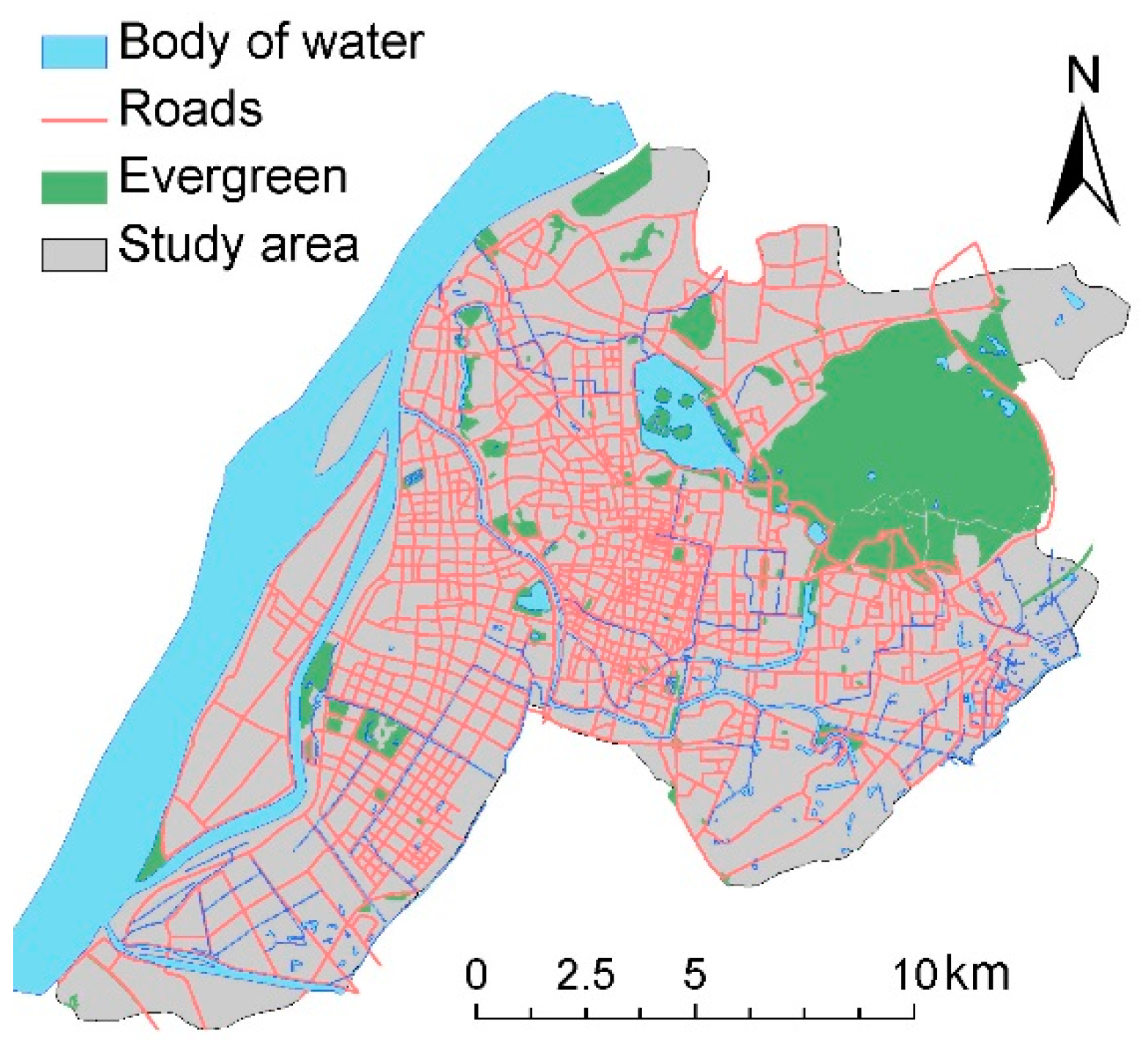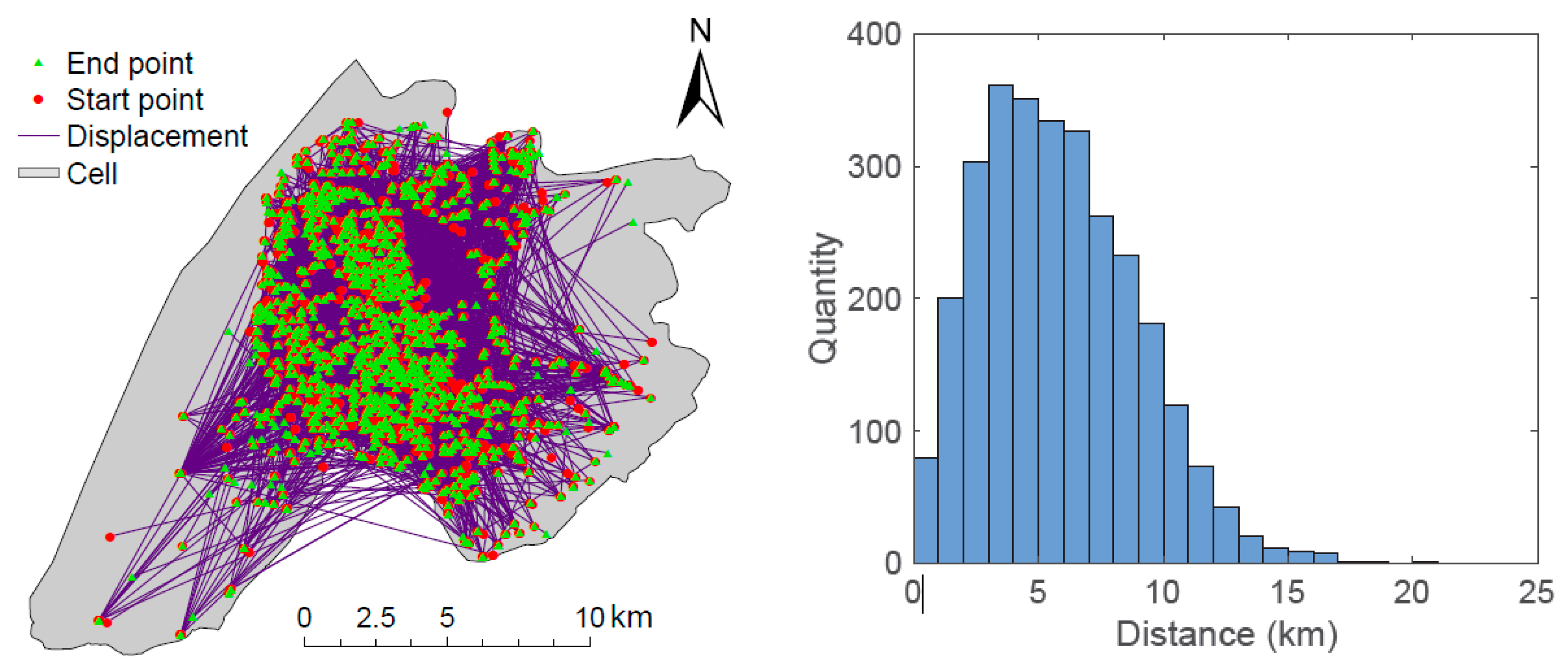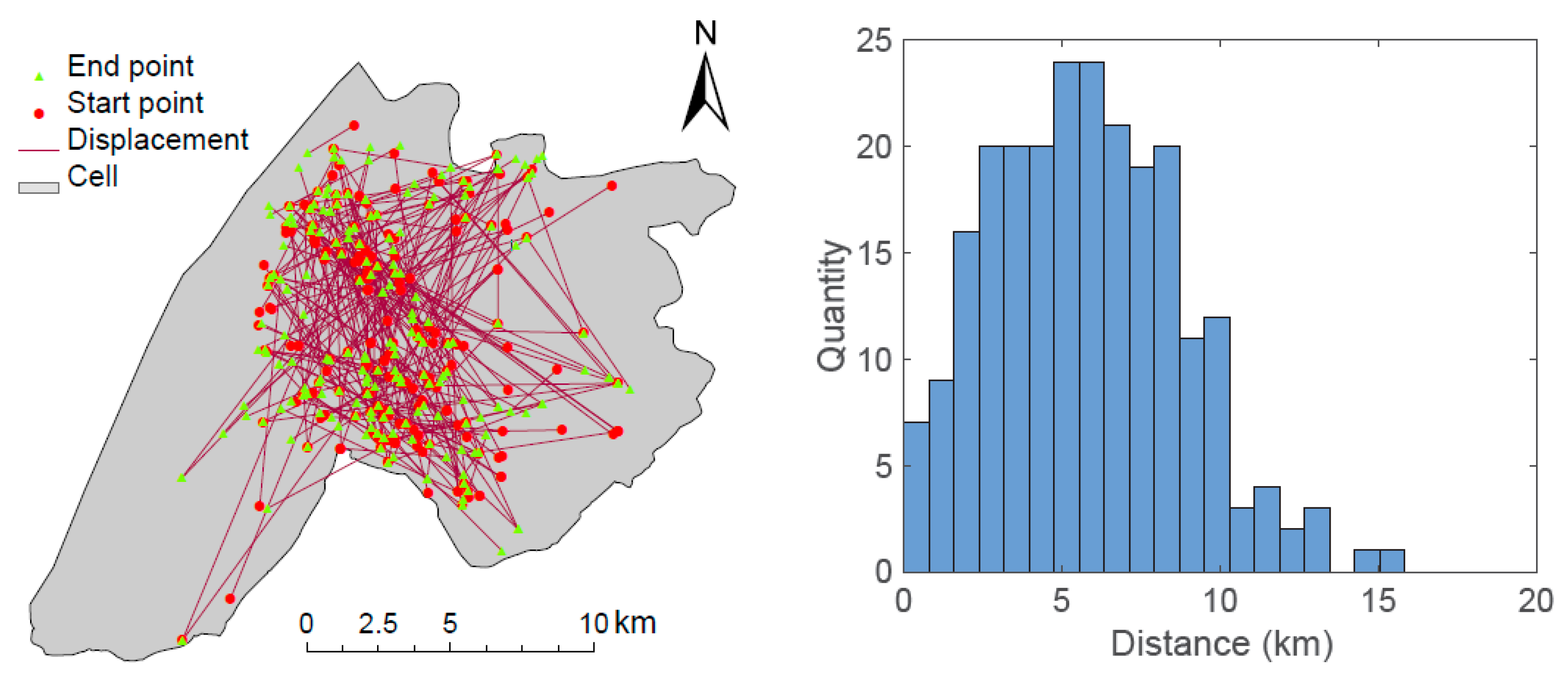Crime Geographical Displacement: Testing Its Potential Contribution to Crime Prediction
Abstract
1. Introduction
2. Methodology
2.1. Overview
2.2. Repeat and Near-Repeat Calculator
2.3. Crime Spatial-Temporal Displacement Detector
2.4. Accuracy Assessment
3. Study Area and Data
4. Results and Analysis
4.1. Crime Prediction Ability of RNR and STCD
4.2. Significant STCD
4.3. Predictive Ability Analysis
5. Discussion
6. Conclusions
Author Contributions
Funding
Acknowledgments
Conflicts of Interest
References
- Bowers, K.J.; Johnson, S.D. Measuring the geographical displacement and diffusion of benefit effects of crime prevention activity. J. Quant. Criminol. 2003, 19, 275–301. [Google Scholar] [CrossRef]
- Brantingham, P.L.; Brantingham, P.J. A conceptual model for anticipating crime displacement. In Proceedings of the 52nd American Society of Criminology Annual Meeting, San Francisco, CA, USA, 15–18 November 2000. [Google Scholar]
- Barr, R.; Pease, K. Crime placement, displacement, and deflection. Crime Justice 1990, 12, 277–318. [Google Scholar] [CrossRef]
- Hakim, S.; Rengert, G.F. Crime Spillover; Sage Publications: Beverly Hills, CA, USA, 1981. [Google Scholar]
- Johnson, S.D.; Guerette, R.T.; Bowers, K.J. Crime displacement: What we know, what we don’t know, and what it means for crime reduction. J. Exp. Criminol. 2014, 10, 549–571. [Google Scholar] [CrossRef]
- Eck, J.E. The threat of crime displacement. In Criminal Justice Abstracts; EBSCO Information Services: Ipswich, MA, USA, 1993; pp. 527–546. [Google Scholar]
- Ratcliffe, J.H.; Breen, C. Crime diffusion and displacement: Measuring the side effects of police operations. Prof. Geogr. 2011, 63, 230–243. [Google Scholar] [CrossRef]
- Weisburd, D.; Wyckoff, L.A.; Ready, J.; Eck, J.E.; Hinkle, J.C.; Gajewski, F. Does crime just move around the corner? A controlled study of spatial displacement and diffusion of crime control benefits. Criminology 2006, 44, 549–592. [Google Scholar] [CrossRef]
- Shariati, A.; Guerette, R.T. Situational crime prevention. In Preventing Crime and Violence; Springer: New York, NY, USA, 2017; pp. 261–268. [Google Scholar]
- Guerette, R.T.; Bowers, K.J. Assessing the extent of crime displacement and diffusion of benefits: A review of situational crime prevention evaluations. Criminology 2009, 47, 1331–1368. [Google Scholar] [CrossRef]
- Braga, A.A. The effects of hot spots policing on crime. ANNALS Am. Acad. Polit. Soc. Sci. 2001, 578, 104–125. [Google Scholar] [CrossRef]
- Bennett, T.; Wright, R.; Wright, R. Burglars on Burglary: Prevention and the Offender; Gower Aldershot: Aldershot, UK, 1984. [Google Scholar]
- Cohen, L.E.; Felson, M. Social change and crime rate trends: A routine activity approach. Am. Sociol. Rev. 1979, 44, 588–608. [Google Scholar] [CrossRef]
- Brantingham, P.J.; Brantingham, P.L. Environmental Criminology; Sage Publications: Beverly Hills, CA, USA, 1981. [Google Scholar]
- Cornish, D.B.; Clarke, R.V. Understanding crime displacement: An application of rational choice theory. Criminology 1987, 25, 933–948. [Google Scholar] [CrossRef]
- Johnson, S.D.; Guerette, R.T.; Bowers, K.J. Crime displacement and diffusion of benefits. In The Oxford Handbook of Crime Prevention; Welsh, B.C., Farrington, D.P., Eds.; Oxford Univeristy Press: New York, NY, USA, 2012; pp. 337–353. [Google Scholar]
- Braga, A.A.; Papachristos, A.V.; Hureau, D.M. The effects of hot spots policing on crime: An updated systematic review and meta-analysis. Justice Q. 2014, 31, 633–663. [Google Scholar] [CrossRef]
- Short, M.B.; Brantingham, P.J.; Bertozzi, A.L.; Tita, G.E. Dissipation and displacement of hotspots in reaction-diffusion models of crime. Proc. Natl. Acad. Sci. USA 2010, 107, 3961–3965. [Google Scholar] [CrossRef]
- Nakaya, T.; Yano, K. Visualising crime clusters in a space-time cube: An exploratory data-analysis approach using space-time kernel density estimation and scan statistics. Trans. GIS 2010, 14, 223–239. [Google Scholar] [CrossRef]
- Pease, K. Repeat Victimisation: Taking Stock; Home Office Police Research Group: Londond, UK, 1998; Volume 90. [Google Scholar]
- Johnson, S.D. Repeat burglary victimisation: A tale of two theories. J. Exp. Criminol. 2008, 4, 215–240. [Google Scholar] [CrossRef]
- Farrell, G.; Phillips, C.; Pease, K. Like taking candy: Why does repeat victimization occur? Br. J. Criminol. 1995, 35, 384–399. [Google Scholar] [CrossRef]
- Sagovsky, A.; Johnson, S.D. When does repeat burglary victimisation occur? Aust. N. Z. J. Criminol. 2007, 40, 1–26. [Google Scholar] [CrossRef]
- de Melo, S.N.; Andresen, M.A.; Matias, L.F. Repeat and near-repeat victimization in Campinas, Brazil: New explanations from the Global South. Secur. J. 2018, 31, 364–380. [Google Scholar] [CrossRef]
- Bowers, K.J.; Johnson, S.D. Who Commits Near Repeats? A Test of the Boost Explanation. West. Criminol. Rev. 2004, 5, 12–24. [Google Scholar]
- Johnson, S.D.; Summers, L.; Pease, K. Offender as forager? A direct test of the boost account of victimization. J. Quant. Criminol. 2009, 25, 181–200. [Google Scholar] [CrossRef]
- Ratcliffe, J.H. Near Repeat Calculator, version 1.3; Temple University: Philadelphia, PA, USA; The National Institute of Justice: Washington, DC, USA, 2009. [Google Scholar]
- Johnson, S.D.; Bernasco, W.; Bowers, K.J.; Elffers, H.; Ratcliffe, J.; Rengert, G.; Townsley, M. Space-time patterns of risk: A cross national assessment of residential burglary victimization. J. Quant. Criminol. 2007, 23, 201–219. [Google Scholar] [CrossRef]
- Chainey, S.; Tompson, L.; Uhlig, S. The utility of hotspot mapping for predicting spatial patterns of crime. Secur. J. 2008, 21, 4–28. [Google Scholar] [CrossRef]
- Wang, Z.; Liu, X. Analysis of burglary hot spots and near-repeat victimization in a large Chinese city. ISPRS Int. J. Geo Inf. 2017, 6, 148. [Google Scholar] [CrossRef]
- Wang, Z.; Zhang, H. Could crime risk be propagated across crime types? ISPRS Int. J. Geo Inf. 2019, 8, 203. [Google Scholar] [CrossRef]
- Wang, Z.; Zhang, H. Understanding the spatial distribution of crime in hot crime areas. Singap. J. Trop. Geogr. 2019, 40, 1–14. [Google Scholar] [CrossRef]
- Song, G.; Liu, L.; Bernasco, W.; Xiao, L.; Zhou, S.; Liao, W. Testing indicators of risk populations for theft from the person across space and time: The significance of mobility and outdoor activity. Ann. Am. Assoc. Geogr. 2018, 108, 1370–1388. [Google Scholar] [CrossRef]
- Liu, L.; Feng, J.; Ren, F.; Xiao, L. Examining the relationship between neighborhood environment and residential locations of juvenile and adult migrant burglars in China. Cities 2018, 82, 10–18. [Google Scholar] [CrossRef]
- Song, G.; Liu, L.; Bernasco, W.; Zhou, S.; Xiao, L.; Long, D. Theft from the person in urban China: Assessing the diurnal effects of opportunity and social ecology. Habitat Int. 2018, 78, 13–20. [Google Scholar] [CrossRef]
- Short, M.B.; D’orsogna, M.R.; Pasour, V.B.; Tita, G.E.; Brantingham, P.J.; Bertozzi, A.L.; Chayes, L.B. A statistical model of criminal behavior. Math. Model. Methods Appl. Sci. 2008, 18, 1249–1267. [Google Scholar] [CrossRef]
- Liu, H.; Brown, D.E. Criminal incident prediction using a point-pattern-based density model. Int. J. Forecast. 2003, 19, 603–622. [Google Scholar] [CrossRef]
- Shiode, S.; Shiode, N. Microscale Prediction of Near-Future Crime Concentrations with Street-Level Geosurveillance. Geogr. Anal. 2014, 46, 435–455. [Google Scholar] [CrossRef]




| Space Distance (meter) | Time Distance (day) | ||||||
|---|---|---|---|---|---|---|---|
| 0–7 | 8–14 | 15–21 | 22–28 | 29–35 | 36–42 | >43 | |
| Same location | 2.76 ** | 1.33 ** | 1.18 ** | 1.21 ** | 1.13 * | 1.18 * | 1.18 * |
| 1–200 | 1.39 ** | 1.08 ** | 1.06 * | 1.11 ** | 1.05 * | 1.08 * | 1.09 * |
| 201–400 | 1.20 ** | 1.09 * | 1.10 ** | 1.08 ** | 1.10 * | 1.08 * | 1.08 * |
| 401–600 | 1.14 ** | 1.10 ** | 1.08 * | 1.04 * | 1.07 * | 1.07 * | 1.08 * |
| 601–800 | 1.12 ** | 1.07 * | 1.07 * | 1.06 * | 1.04 * | 1.06 * | 1.07 * |
| 801–1000 | 1.12 ** | 1.05 * | 1.04 * | 1.06 * | 1.03 | 1.05 * | 1.07 * |
| >1000 | 1.07 * | 1.03 * | 1.03 * | 1.04 | 1.06 * | 1.07 * | 1.07 * |
| Method | Capture Count | Capture Rate | PAI |
|---|---|---|---|
| RNR | 2975 | 34.75% | 14.85 |
| STCD | 911 | 10.64% | 4.547 |
| RNR + STCD | 3596 | 42.00% | 17.95 |
| Increased by STCD | 621 | 7.25% | 3.1 |
© 2019 by the authors. Licensee MDPI, Basel, Switzerland. This article is an open access article distributed under the terms and conditions of the Creative Commons Attribution (CC BY) license (http://creativecommons.org/licenses/by/4.0/).
Share and Cite
Wang, Z.; Liu, L.; Zhou, H.; Lan, M. Crime Geographical Displacement: Testing Its Potential Contribution to Crime Prediction. ISPRS Int. J. Geo-Inf. 2019, 8, 383. https://doi.org/10.3390/ijgi8090383
Wang Z, Liu L, Zhou H, Lan M. Crime Geographical Displacement: Testing Its Potential Contribution to Crime Prediction. ISPRS International Journal of Geo-Information. 2019; 8(9):383. https://doi.org/10.3390/ijgi8090383
Chicago/Turabian StyleWang, Zengli, Lin Liu, Hanlin Zhou, and Minxuan Lan. 2019. "Crime Geographical Displacement: Testing Its Potential Contribution to Crime Prediction" ISPRS International Journal of Geo-Information 8, no. 9: 383. https://doi.org/10.3390/ijgi8090383
APA StyleWang, Z., Liu, L., Zhou, H., & Lan, M. (2019). Crime Geographical Displacement: Testing Its Potential Contribution to Crime Prediction. ISPRS International Journal of Geo-Information, 8(9), 383. https://doi.org/10.3390/ijgi8090383






